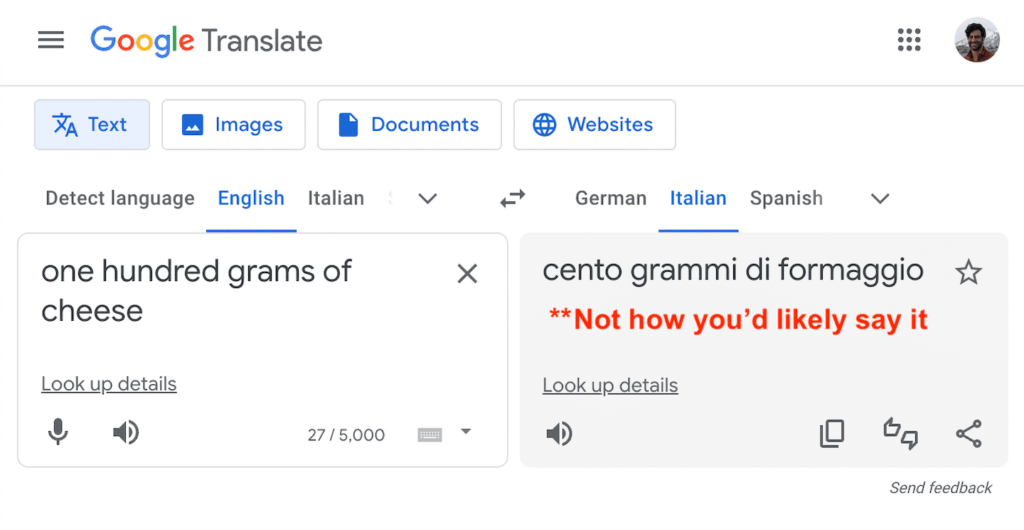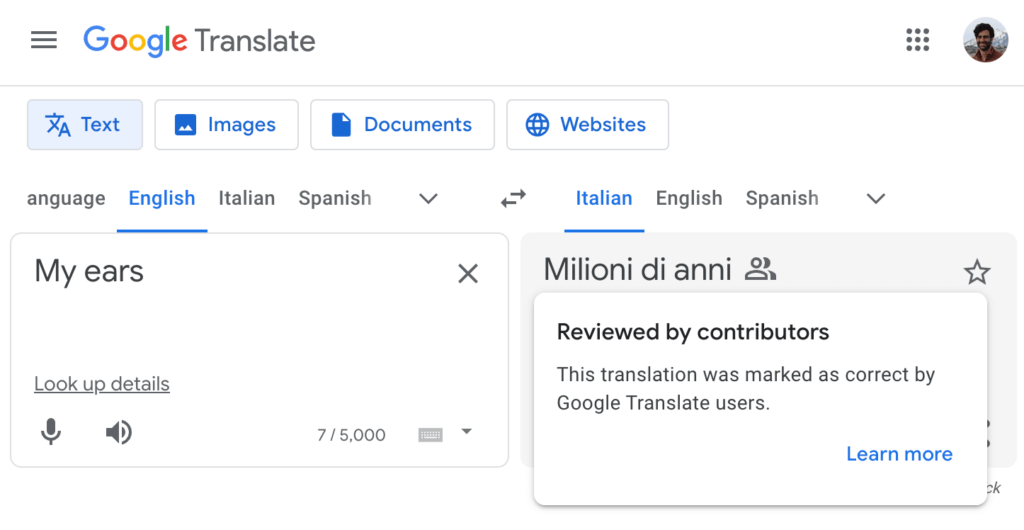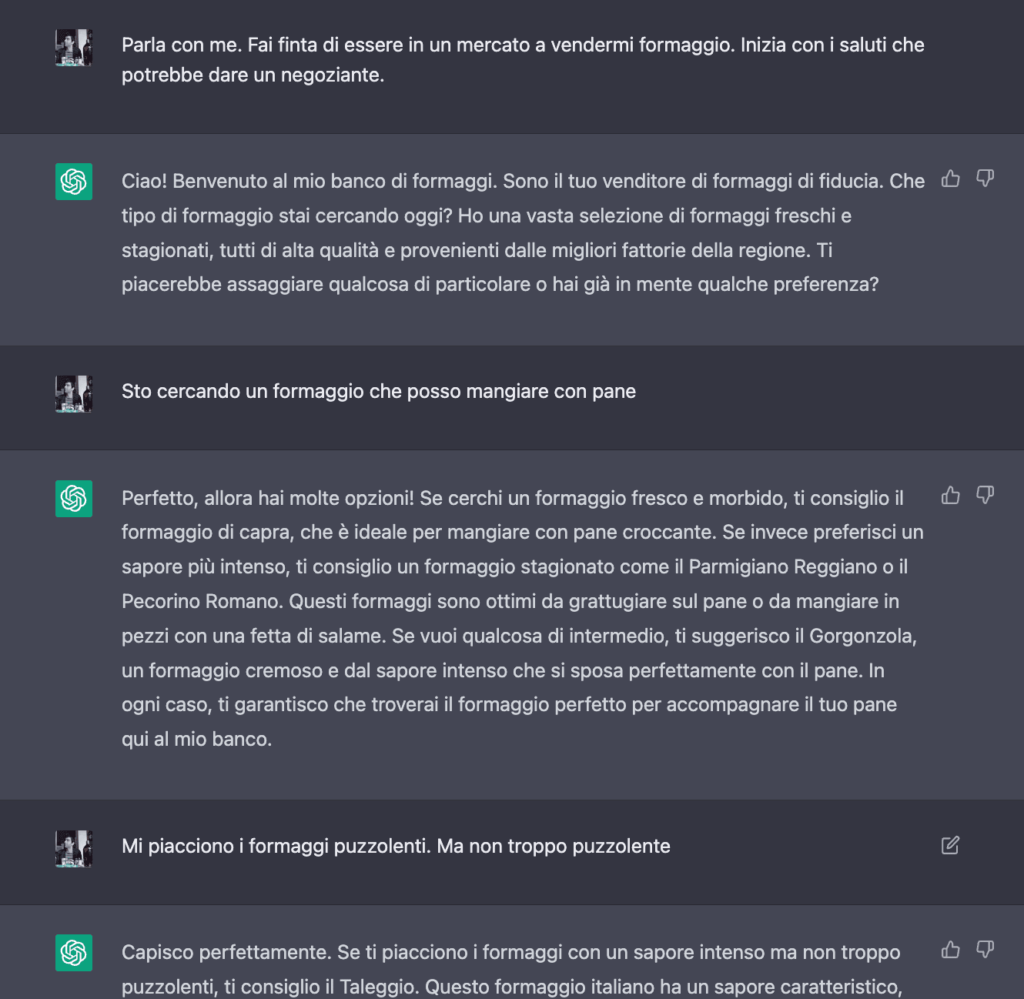AI for Language Learning — State of the Art
There are a few apps and tools coming out that are AI-supported language learning tools.
But what you might not realise is that AI in language learning and linguistics has been around for a long time before we really started thinking about it. It’s just becoming a bit of a buzzword these days, and a few different ways of accessing AI have come around.
Because there are some interesting things you can do with AI for language learning, I thought I’d share some ideas from my own experimentation.
Note — AI is advancing rapidly. I’ll update this post as necessary, or post more later.
You might also enjoy my suggestion of following your curiosity with language learning.

Where Has AI Been Around in Language Learning Already?
The main places you’ll have already seen AI in language learning, even if it wasn’t called that, are in translation tools like Google Translate, and in natural language sentence example websites like Reverso.
So if you ever look things up in Google Translate, you’ve already used AI for language learning. You’re on your way!
Tools like Google Translate aren’t made by hand. Nobody went in there and manually programmed millions of examples of conjugations and cases. The data comes from what’s already out there in the form of many documents that already exist in many languages, often conveniently translated. (Here’s a quick overview of some of the machine translation work that has gone into Google Translate. And this is a few years old!)
Another tool I end up using quite often is Reverso.net. This is “contextual translation”. It takes documents that exist in multiple languages and parses them into phrases, and then lets you go search for phrases in any language.
Reverso is fun and useful, especially for colloquial stuff. But it’s nowhere near as smart as Google’s tools, and suffers a bit from the fate of the snake eating its own tail — some of the translation sources it uses are clearly other machine translation efforts.
And a final quite interesting place where AI has been around for a while is Duolingo. Yes, your friendly neighbourhood owl!
Duolingo has been using AI in a number of ways for many years. One of the more established ways is the way they develop an AI model of your knowledge, after you’ve done a number of exercises, through an internal system called Birdbrain. Duolingo uses this to customise content towards you to maximise your engagement — nothing too hard, nothing too easy. Here’s an article from Venturebeat showing all the way Duolingo uses AI. Again, years old.
“I’m sorry,” you think. “I thought you were going to talk about ChatGPT.” Well, I am. Relax!
But first, some words of warning.
Before You Dive In — Pitfalls and Gotchas
Before you start getting too into “AI for Everything!!1”, I think it’s important to know the things that can go wrong when learning language from AI tools.
Is this the real life?
Firstly, know your goals. For many people interested in travel and culture, the goal of learning a language is to be able to do stuff in other countries or other cultural environments.
For example, in a couple of months, I’ll be in Italy. My goal is to buy cheese, to grease the wheel of my relationship with my partner. I won’t buy cheese through a text interface, but with a live person looking at me in a busy, noisy, distracting aroma-filled market, with not much time, and possibly talking with an odd accent.
In light of this, yes, a chat tool can help me learn phrases like “Do you want it sliced?” or “How many grams?”. But it’s a distant echo of reality, about as close as an emoji is to someone’s face.
I’ll never forget the first time a young Dana met my first landlord in Spain, decades ago. I was a very young man, and she turned out to be a beautiful woman. My friend who accompanied me had to translate from Spanish to Spanish for me, because when I was looking at my landlord, I promptly forgot every bit of Spanish I knew.
(Maybe there’ll be an app for that situation at some point…)
Finally, don’t fall into the general “unproductivity trap” of apps, a common language-learning mistake. They’re low-stress and fun to play with. There’s nothing wrong with fun of course. But don’t overdo it.
Un-colloquial as Heck
If you’ve used translation tools, you’ll know that they tend to focus on lowest-common-denominator translations. For example, if you look up “100g of cheese” in Italian, it’ll tell you to say “cento grammi di formaggio“. Looks right, right? “Cento grammi” is surely “one hundred grams”. But in Italy, they say “un etto” for a 100g unit.

That’s just the beginning and a very simple example. There are colloquial phrasings for many everyday things in every language, all the way to slang and swearwords. The only way I ever figure these out is by asking people.
Where AI (and most translation tools) really falls apart is in dialects or spoken languages, many of which can have hundreds of millions of speakers.
So if you want to use AI for language learning, realise its limitation: At this stage, it’s best for standard speech in the most widely-documented languages.
To Err is Human(oid)
Finally, AI makes mistakes. I know, the old aphorism ends with “To forgive divine.” But I don’t forgive computers for making errors. “Not making errors” is the main reason I use this glorified calculator.
AI makes mistakes in translation, tone, phrasing, and even explanations of grammar and syntax. It fails to pick up things that need correcting. Basically, it’s an unreliable source that just sounds very convincing.

This will definitely get better with time, though. It’s hard for me to say when and by how much, but I know it will. Just for now at at least the next 24h (maybe!), don’t trust it blindly.
Using AI for Language Learning — We’re We Are At
If you’ve used ChatGPT at all, you might have realised: “Hey, I can maybe use this or some other AI for language learning. Or getting rich somehow” (no, I don’t know how to do that yet. I don’t even think they do, for sure.)
Here are some cool things I’ve done that you might find interesting. For ChatGPT / OpenAI, I’ll include prompts where that’s useful.
I use a few of these AI tools for language learning regularly and quite enjoy it. They don’t really take the place of my standard language learning methods completely, though.
Make sure you read the “Pitfalls and Gotchas” section. It’s important. Basically, second-guess all the content, and look for other sources.
Get Sample Sentences
The first thing I enjoy doing with AI is getting sample sentences. I use ChatGPT for this with a simple prompt like “Write me ten sample sentences with translations using the Spanish verb “bastar”, in different conjugations.”
Then, I get these, check them, listen to them (usually in Google Translate), and then, if necessary, throw them into an Anki deck with audio.
It’ll get next level when there’s built-in text-to-speech, but even without that, I’m pretty happy.
Correct things
You can get AI to check your diary entries. Keeping a diary in another language is a really useful way of learning / keeping fresh vocabulary and phrasing about your everyday life.
I like to use Google Docs or Microsoft Office (which is free online, too), which have built-in grammar and spelling correction tools that work in many languages. Generally the way I write a diary is
- I think of what I’m trying to say
- I try to write it in another language
- I get dictionaries / translation tools to help me with words and phrasing I don’t know
- Then I correct it using an AI tool (Google Docs’ grammar support, or even ChatGPT)
It’s the last step that AI can help with.
Make an AI-Powered Language Partner
Finally, one of the fun things I’ve done recently is to use ChatGPT to simulate being a language partner.
After some experimentation, I realised the best thing to do was to write a prompt in the language I want to practise.
For example, I asked ChatGPT to pretend it was selling me cheese.

This is quite fun. It really helps with thinking of the words I’m likely to say or understand, without me having to imagine both sides of the conversation. I realised I didn’t know the word for “smelly”, for example.
Of course, see the pitfalls above. This is hardly a realistic conversation. It’s too wordy, it’s in an informal tone (excuse me, I’m a man in my forties; who are you calling “tu”; that’s just how I was talking to the AI!), it reads like a mini-essay (You don’t need a conclusion in a conversation), and so on.
Where to next?
AI is evolving rapidly, and there are more AI for language learning coming out all the time. I’ve already seen some tools by Duolingo and other smaller developers who are trying to make AI-powered language learning tools. Even we’re working on them!
If there’s anything you want to share with us, send it our way, either as a comment or by contacting us.






